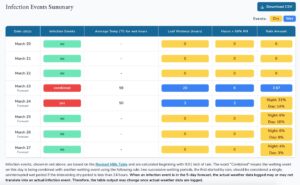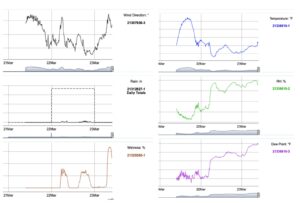Purdue recently joined and became one of twenty US states that are in the NEWA network. NEWA is a partnership of land grant universities and grower associations. If you live in one of the states listed, you can buy a weather station for your farm and connect to NEWA. For Indiana growers, this means your membership is covered in full. If you live in a different state, see the NEWA Partners page to check out the Ricky Bobby branding and find out more about your membership status.
What is NEWA?
The Network for Environment and Weather Applications (NEWA) delivers weather data from weather stations primarily located on farms through the Internet at newa.cornell.edu and automatically calculates and displays weather data summaries, crop production tools, and integrated pest management (IPM) forecasts.
How does NEWA and a weather station benefit me?
- Promotes better and more precise IPM, reduced pesticide use, improved environmental protection.
- Better crop management, improved crop quality, improved yield.
- Enhanced decision support.
Okay, I’m interested. How does it work?
NEWA works with Onset Data Loggers and KestrelMet (weather stations) which are configured for NEWA’s agricultural production tools. These stations provide the data to the NEWA system, and look like this:
In this format, the data isn’t super helpful for most people, but I know I piqued your interest if you’ve read this far. Keep reading…
How does NEWA help in crop management decision making?
As a nerd, the data above is really exciting, but it doesn’t help me to make decisions. To do that, the data needs to be entered into appropriate mathematical models correctly to make it useful. Most people don’t want to sit down and calculate degree days (DD) and growing degree days (GDD) with base temperatures for different crops, and then use that data for additional models to forecast insect hatch dates and plant disease infection periods. I sure don’t (it’s super tedious and easy to make mistakes). So, NEWA does this calculation for you and displays the data:

Figure 2a-c. Tools are provided in graphical form (top) and table form (middle and bottom). These data are from an orchard in Hendersonville, NC, taken 3/22/22).
There are over 20 weather-based IPM forecast tools in NEWA (see below for links to access those tools). Many tools in NEWA address apple and grape decision support. There are 14 pest problems for apples (fire blight, apple scab, sooty blotch & flyspeck, spotted tentiform leafminer, oriental fruit moth, codling moth, plum curculio, oblique-banded leafroller, apple maggot, San Jose scale, apple carbohydrate thinning, apple irrigation, apple evapotranspiration, and apple frost risk) and 5 for grapes (Phomopsis cane and leaf spot, powdery mildew, black rot, downy mildew, and grape berry moth). These crop risk assessment tools are available as part of the NEWA 3.0 online decision support platform. These useful resources make the process of tracking pest and disease risk easier and more efficient.
Nerding out is great, but how does this help my bottom line?
A 2017 survey found that NEWA users in New York saved $4329 in spray costs per year, on average. Prevented per crop loss was valued at $33K annually by growers as a direct result of using NEWA IPM tools and resources.
Keep in mind, these are just tools to help you better time pesticide applications. They aren’t going to do the spraying for you or help you with the decisions as to what to spray See the Midwest Fruit Pest Management Guide for that information!). From my observation, experienced growers are often doing these calculations without even realizing it. For them, this tool provides a notification or reminder so they aren’t in a constant state of alert wondering when to spray, and protects against missed sprays. For new growers, it helps them develop the experience by providing notifications of what they need to prepare for.
Like any tool, some people use them better than others. However, there is a robust set a literature, webinars, and papers to help you, if you need or want additional information!
For more information:
Visit the NEWA online Knowledge Base to quickly get started with NEWA 3.0
https://newa.zendesk.com/hc/en-us/categories/4417359987223
Apple management resources
https://newa.zendesk.com/hc/en-us/categories/4416890573719
Grape management resources
https://newa.zendesk.com/hc/en-us/categories/4416914053911
Vegetable management resources
https://newa.zendesk.com/hc/en-us/categories/4416921096727
Field crop management resources
https://newa.zendesk.com/hc/en-us/categories/4417250145943
Additional user support
Contact the NEWA Help Desk if you have any problems, have questions or (especially) if you find a bug or glitch. Do this by sending an email to support@newa.zendesk.com with details, screenshots, and other information that might be helpful for a quick resolution.
For additional information:
https://newa.cornell.edu/crop-and-pest-management/
https://nyshs.org/wp-content/uploads/2017/05/Carroll-Pages-19-24-from-NYFQ-spring-book-2017-4.pdf


